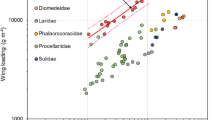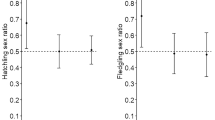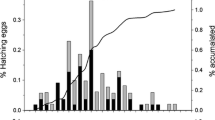Abstract
Mass loss of breeding birds might be due to the physiological stress of breeding or it could be an adaptation to lower the costs of flight to the feeding areas. We examined the natural variation in the adult body mass of Wilson’s storm petrels Oceanites oceanicus on King George Island, South Shetland Islands over four breeding seasons. During two seasons, the prey abundance was high, while it was poor during the other two seasons. Only breeding birds were sampled; the fluctuations in mass were similar among males and females. During incubation, the mass of the adults was high in good seasons and low in poor seasons. Thus, body mass during incubation was determined by energetic constraints. However, during chick feeding, adults lost mass in the good seasons but gained mass in the poor seasons, suggesting that mass loss during chick rearing is not primarily caused by stress, but is regulated adaptively. Adults in poor conditions may buffer against unpredictable food supply by increasing their own body mass, even at the expense of the chick. Reduced body condition at the beginning of the breeding season was associated with reduced egg volumes and late laying, suggesting that the initial body condition influenced the level of investment in the current breeding attempt.






Similar content being viewed by others
References
Beck JR, Brown DW (1972) The biology of Wilson’s Storm petrel, Oceanites oceanicus (Kuhl), at Signy Island, South Orkney Islands. BAS Sci Rep 69:1–54
Büßer C, Kahles A, Quillfeldt P (2004) Breeding success and chick provisioning in Wilson’s storm-petrels Oceanites oceanicus over seven years—frequent failures due to food shortage and entombment. Polar Biol 27:613–622
Carrascal LM, Polo V (1999) Coal tits, Parus ater, lose weight in response to chases by predators. Anim Behav 58:281–285
Chastel O, Weimerskirch H, Jouventin P (1995) Body condition and seabird reproductive performance: a study of three petrel species. Ecology 76:2240–2246
Cichoñ M (2001) Body-mass changes in female collared flycatchers: state-dependent strategy. Auk 118:550–552
Covas R, Brown CR, Anderson MD, Brown MB (2002) Stabilizing selection on body mass in the sociable weaver Philetairus socius. Proc R Soc Lond B 269:1905–1909
Croll DA, Gaston AJ, Noble DG (1991) Adaptative loss of mass in thick-billed murres. Condor 93:496–502
Croxall JP, Hill HJ, Lidsone-Scott R, O’Connell MJ, Prince PA (1988) Food and feeding ecology of Wilson’s storm petrel Oceanites oceanicus at South Georgia. J Zool 216:83–102
Cuthill IC, Houston AI (1997) Managing time and energy. In: Krebs JR, Davies NB (eds) Behavioural ecology: an evolutionary approach. Blackwell Scientific, Cambridge, pp 97–120
Freed LA (1981) Loss of mass in breeding wrens: stress or adaptation? Ecology 62:1179–1186
Furness RW, Furness BL (1981) A technique for estimating the hatching dates of eggs of unknown laying date. Ibis 123:98–102
Gaston AJ, Jones IL (1989) The relative importance of stress and programmed anorexia in determining mass loss by incubating ancient murrelets. Auk 106:653–658
Gaston AJ, Perin S (1993) Loss of mass in breeding Brunnich’s guillemots Uria lomvia is triggered by hatching. Ibis 135:472–475
Gentle LK, Gosler AG (2001) Fat reserves and perceived predation risk in the great tit, Parus major. Proc R Soc Lond B 268:487–491
Griffiths R, Daan S, Dijkstra C (1996) Sex identification in birds using two CHD genes. Proc R Soc Lond B 263:1251–1256
Hahn S, Peter H-U, Quillfeldt P, Reinhardt K (1998) The birds of the Potter Peninsula, King George Island, South Shetland Islands, Antarctica, 1965–1998. Mar Ornithol 26:1–6
Holt S, Whitfield DP, Duncan K, Rae S, Smith RD (2002) Mass loss in incubating Eurasian dotterel: adaptation or constraint? J Avian Biol 33:219–224
Jones IL (1994) Mass change of least auklets Aethia pusilla during the breeding season: evidence for programmed loss of mass. J Anim Ecol 63:71–78
Lima SL (1986) Predation risk and unpredictable feeding conditions: determinants of body mass in birds. Ecology 67:377–385
Masello JF, Quillfeldt P (2003) Body size, body condition and ornamental feathers of burrowing parrots: variation between years and sexes, assortative mating and influences on breeding success. Emu 103:149–161
Møller AP, Christe P, Erritzøe J, Mavarez J (1998) Condition, disease and immune defence. Oikos 83:301–306
Norberg RÅ (1981) Temporary weight decrease in breeding birds may result in more fledged young. Am Nat 118:839–850
Nur N (1984) The consequences of brood size for breeding blue tits. 1. Adult survival, weight change and the cost of reproduction. J Anim Ecol 53:479–496
Priddle J, Croxall JP, Everson I, Heywood RB, Murphy EJ, Prince PA, Sear CB (1988) Large-scale fluctuations in distribution and abundance of krill—a discussion of possible causes. In: Sarhage D (ed) Antarctic ocean and resources variability. Springer-Verlag, Berlin, pp 169–182
Quillfeldt P (2001) Variation of breeding success in Wilson’s storm-petrels: influence of environmental factors. Antarct Sci 13:400–409
Quillfeldt P (2002) Seasonal and annual variation in the diet of breeding and non-breeding Wilson’s storm-petrels on King George Island, South Shetland Islands. Polar Biol 25:216–221
Quillfeldt P, Peter H-U (2000) Provisioning and growth in chicks of Wilson’s storm-petrels Oceanites oceanicus on King George Island, South Shetland Islands. Polar Biol 23:817–824
Quillfeldt P, Schmoll T, Peter H-U, Epplen JT, Lubjuhn T (2001) Genetic monogamy in Wilson’s Storm-Petrel. Auk 118:245–251
Ricklefs RE (1974) Energetics of reproduction in birds. In: Nuttall Ornithological Club (ed) Avian energetics. Nuttall Ornithological Club, Cambridge, MA, pp 152–297
Ricklefs RE (1983) Some considerations on the reproductive energetics of pelagic seabirds. Stud Avian Biol 8:84–94
Ridoux V (1994) The diets and dietary segregation of seabirds at the subantarctic Crozet Islands. Mar Ornithol 22:1–192
Ridoux V, Offredo C (1989) The diets of five summer breeding seabirds in Adelie Land, Antarctica. Pol Biol 9:137–146
Roberts B (1940) The life cycle of Wilson’s petrel Oceanites oceanicus (Kuhl.). Sci Rep Br Graham Land Exped 1:141–194
Siegel V (1986) Untersuchungen zur Biologie des Antarktischen Krill Euphausia superba, im Bereich der Bransfield Strasse und angrenzender Gebiete. Mitt Inst f Seefisch, Hamburg 38:1–244
Trivers RL (1974) Parent–offspring conflict. Am Zool 14:249–264
Wasilewski A (1986) Ecological aspects of the breeding cycle in the Wilson’s Storm Petrel, Oceanites oceanicus (Kuhl.), at King George Island (South Shetland Islands, Antarctica). Pol Polar Res 7:173–216
Wendeln H, Becker PH (1999) Effects of parental quality and effort on the reproduction of common terns. J Anim Ecol 68:205–214
Witter MS, Cuthill IC (1993) The ecological costs of avian fat storage. Phil Trans R Soc Lond B 340:73–92
Acknowledgements
We would like to thank Hans-Ulrich Peter, Tim Schmoll and Steffen Hahn for their contributions to logistics and fieldwork. We received logistic support from the Alfred-Wegner Institute of Marine and Polar Research (Bremerhaven, Germany), the National Antarctic Institute of Argentina and Hapag Lloyd Seetouristik GmbH. This study was partly funded by grants provided by Deutsche Forschungsgemeinschaft (Qu148, Lu572), Studienstiftung des Deutschen Volkes and the State of Thuringia, Germany (Landesgraduiertenstipendium). The manuscript benefited from the comments of three anonymous referees.
Author information
Authors and Affiliations
Corresponding author
Rights and permissions
About this article
Cite this article
Quillfeldt, P., Masello, J.F. & Lubjuhn, T. Variation in the adult body mass of Wilson’s storm petrels Oceanites oceanicus during breeding. Polar Biol 29, 372–378 (2006). https://doi.org/10.1007/s00300-005-0066-5
Received:
Revised:
Accepted:
Published:
Issue Date:
DOI: https://doi.org/10.1007/s00300-005-0066-5




